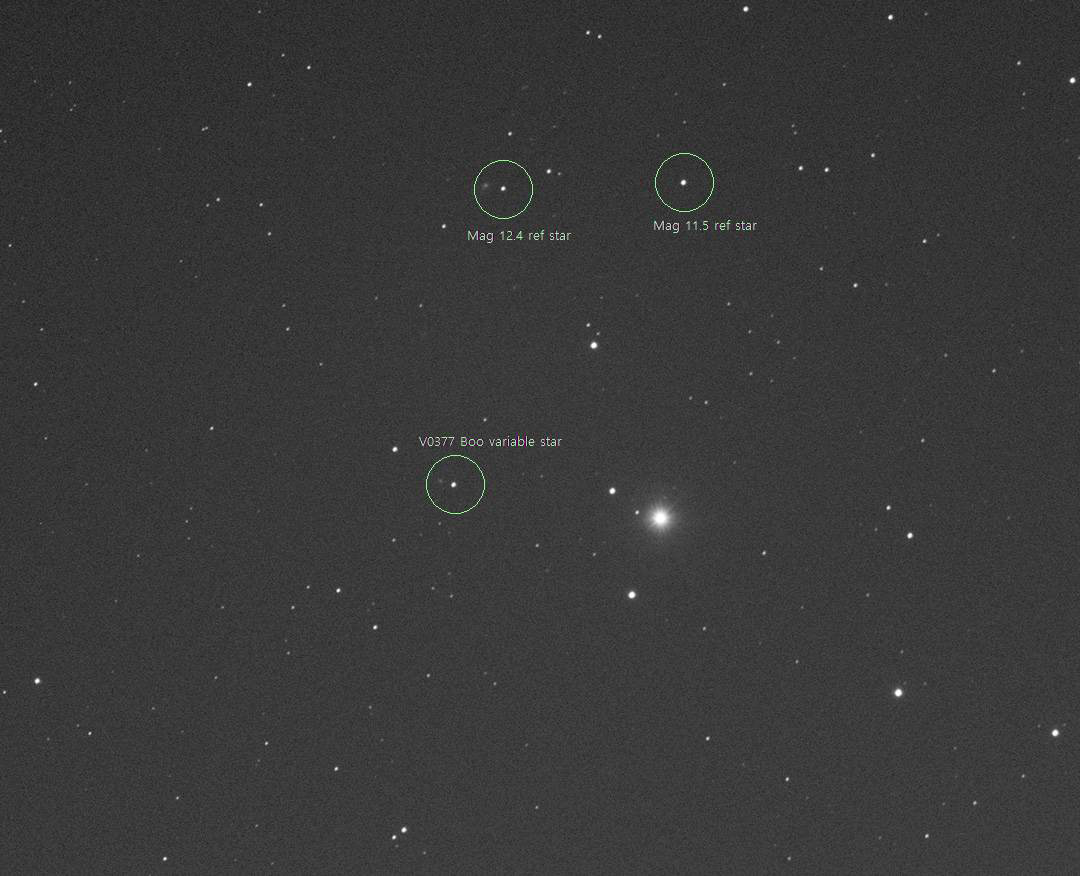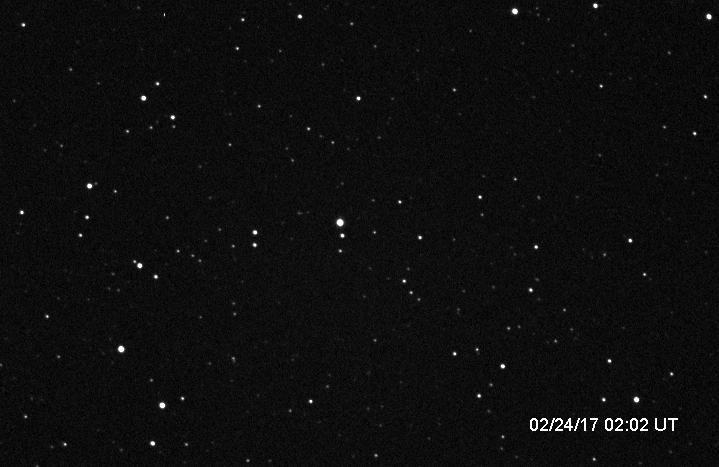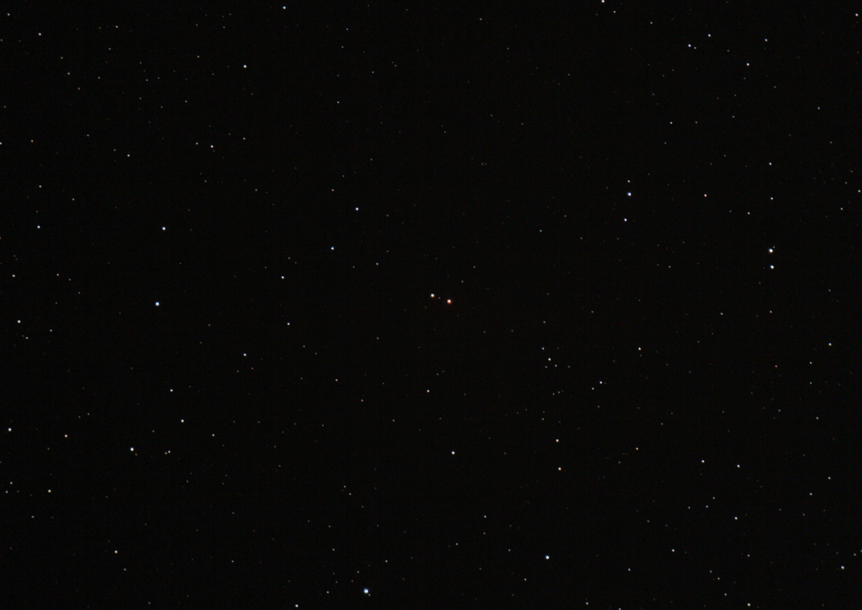Novae & Variable Stars
V0377 Bootis Photometry - Aug. 8, 2021

While readig the current issue of Astronomy Technology Today,
an advertisment from AAVSO (American Association of Variable Star Observers) caught my eye.
The ad's caption said
"You have the gear, what will you do with it? Make a real contribution to science".
Since I am generally insterested in variable stars, I thought "Why not give this a try?".
It took over a month waiting for decent weather, but I got it done and it was a lot of fun.
Click on the image above and it will take you to my web page showing how I did it.
It's like a mini presentation so scroll down to see it all especially my light curve of V0377 Boo.
Click on the image to see the details!
Back to Mark's Astrophotography Home
Nova Cas 2021, M52, and the Bubble Nebula in Cassiopeia - May 14, 2021

Nova Cas 2021 (V1405 Cas) near M52 and the Bubble Nebula.
The photo shown is an animated gif consisting of two images:
the first taken on Sept. 20, 2020 before the star went nova and
the second taken on May 14, 2021 with the nova at near magnitude 6.0.
Both frames are crops of about 1/4 of the original frames.
The May photo with the nova was taken during morning twilight at about 5 am at
an altitude of 40 degrees - just above the treeline at my house.
The Sept. photo field was taken at 10:45 pm at altitude 60 degrees.
Location: Cary, NC in my front yard
Camera: ASI294MC-pro gain:120
Exposures: Sept. 2020 - 15 x 45 sec
Exposures: May 2021 - 15 x 45 sec
Filter: none
Scope: TeleVue Genesis 4" f/5 refractor
Mount: iOptron GEM-45
Guider: none
Capture software: APT
Guiding software: none
Processing software: Pixinsight and Photoshop
Notes:
Pixinsight was used for data reduction, align, stack, ABE, Photometric CC,
and convert to tiff for both the Sept. and May sets of data.
PI was then used to star align the Sept. and May data and crop it.
Photoshop CC was for GradXterminator, resize, and convert to animated gif.
I had lots of help with scope setup, polar alignment, and focus from my wife Phyllis
in May due to my back pain at the time.
For a larger view in a new window, click on the image.
Back to Mark's Astrophotography Home
Chi Cygni July 24, 2019 and Mar. 8, 2021

Variable star Chi Cygni min to max over 20 months.
The photo at minimum was taken on July 25, 2019 when the star was close to mag. 13.6.
The photo at maximum was taken on March 8, 2021 when the star was close to mag. 5.0.
Both sets of images were taken in my front yard in Cary, NC
with an ASI294mc-pro one shot color camera
along with my 4" f/5 TeleVue Genesis refractor.
The 2019 photos were taken with a Celestron AVx mount and
the 2021 photos were taken on an iOptron GEM-45 mount.
Each set was 15 x 30s exposures unguided.
The field of view in the gif is 1 degree x .75 degrees.
APT software was used to capture the images.
All data was reduced, integrated, and initially processed with PixInsight.
Each set of images was taken to Photoshop CC which created the animation and captions.
For a larger view in a new window, click on the image.
Back to Mark's Astrophotography Home
RW Tauri - Feb. 23, 2017

Eclipsing binary star RW Tauri is located near the Pleiades in Taurus.
Mass is being transferred from a K0 IV secondary star to a B8 V primary star.
About every three days the secondary star eclipses the primary star.
Over the span of about four hours, it goes from normal brightness of around 8.0 magnitude
down to around 11.6 magnitude and back.
I started this sequence after the eclipse had already started,
so RW Tauri was not at its maximum brightness.
The animation was was made up 3 groups of 3 x 10 second images.
I shot 10 groups over the span of an hour and 40 minutes but only used three.
I was using my Televue Genesis 4" f/5 refractor, my SBIG ST-402 CCD camera,
and my Celestron AVX mount.
The images were captured from my front yard in Cary, NC.
I captured and reduced the data in MaximDL,
and made the animated gif in Phtoshop CS2.
Back to Mark's Astrophotography Home
Algol - the demon star in Perseus - Dec. 1, 2016 and Jan. 30, 2017

The animation above shows the eclipsing binary star Algol at normal and minimum brightness.
The Dec.1 photo was taken when Algol was at normal brightness at magnitude 2.1.
The Jan. 30 photo was taken when Algol was at minimum brightness at magnitude 3.4.
Each set of photos was made up from 10 x 20 second exposures at ISO 800.
They were combined and stretched using ImagesPlus,
aligned with Maxim DL, and then taken to Photoshop CS2 for the animation.
I used my Televue Genesis 4" f/5 refractor, a Canon XTi, and my Celestron AVX mount.
Click on the image for a larger view in a new window.
Back to Mark's Astrophotography Home
Click on the image to go to the Mira page.
Mira (Omicron Ceti) - Dec. 7, 2015 and Feb. 27, 2016

Mira (Omicron Ceti) two frame animation. The first photo was taken on Dec. 7, 2015 when Mira was near minimum light around 9th magnitude and second photo was taken on Feb. 27, 2016 when Mira was near maximum light around 3.5 magnitude. This red giant star goes from naked eye visibility to invisibility in only a couple of months. In late February and March it is sinking towards the western horizon, so anyone wanting to see it dim back to minimum will have to wait a few months until it comes back into the morning sky.
These shots were taken at the BigWoods site at Jordan Lake on two different nights.
I imaged with the TeleVue Genesis and my Canon XTi DSLR.
Each frame of the animation was made from 10 x 30 second subs at ISO 800 processed in
ImagesPlus and Photoshop CS2.
The shots were tracked but unguided on the Losmandy G-11 mount.
Click on the image to see a light curve and finder chart for Mira.
Back to Mark's Astrophotography Home
SZ Herculis - July 2, 2007

SZ Herculis is the flashing star near the upper left center of this two frame animated gif. SZ Herculis is a fast eclipsing binary star in the constellation Hercules. This variable star goes from magnitude 10.5 down to about magnitude 12 and back to 10.5 in about 3.5 hours! Each exposure shown here was 20 seconds long. I selected two images out of the approximately 100 I shot. The first frame was taken near minimum light at 11:30 pm and the second frame was taken near maximum light at 12:54 am. I got the idea for this animation from the article in the July 2007 issue of Sky and Telescope magazine.
These shots were taken from my front yard in Cary, NC. Unlike most July evenings, the temperature was nice and the humidity was low. Passing clouds caused interruptions in my planned sequence of photos. I imaged with the Genesis and the ST-402ME and guided with the Stellarvue and the ST-4. Both were mounted side by side on the Losmandy G-11.
Back to the top of the pageBack to Mark's Astrophotography Home
Nova Sagittarii - March 29, 2015

This two frame animation shows Nova Sagittarii's rise from invisibility on this old August 3, 2008 photo
to an estimated magnitude 5.25 on the newer March 29, 2015 photo.
The nova is located near the center of the Sagittarius Teapot asterism featured in this photo.
As of May 1, 2015 the nova has fluctuated up and down multiple times
between magnitude 4.5 and 6.5 with it currently near 6.5.
The nova is roughly centered in the photos.
Both frames of the animation were taken with Canon digital cameras and a regular camera lens.
The first photo was taken on Aug. 3, 2008 from a semi-dark location, probably Bigwoods.
The second photo was taken on Mar. 29, 2013 from North Cary Park which suffers from light pollution.
Stars from the original deeper photo go down to around 10-11th magnitude.
I see no trace of the star which went nova there.
I used MaximDL to align the photos and Photoshop CS2 to make the animation.
Back to the top of the page
Back to Mark's Astrophotography Home